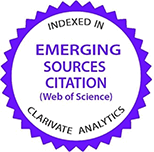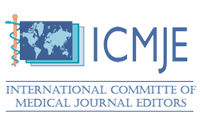Index








Applications



Membership



Volume: 3 Issue: 2 - 2015
| ORIJINAL ARAŞTIRMA | |
| 1. | Oxidative Burst with Dihydrorhodamine Test: Reference Values in Healthy Controls Dilek Çiçekkökü, İsmail Öğütülür, Elif Karakoç Aydıner, Safa Barış, Ayça Kıykım, Ahmet Özen, Işıl Barlan doi: 10.5606/tji.2015.426 Pages 49 - 53 Amaç: Bu çalışmada dihidrorhodamin (DHR) testinde stimülasyon indeksi (Sİ) ve varyasyon katsayısı (VK) verilerinin sağlıklı kontrollerdeki referans değerleri bildirildi. Gereç ve yöntemler: Çalışmaya primer immün yetmezlik uyarıcı bulgusu ve kronik hastalığı olmayan 210 sağlıklı kontrol alındı. Veri analizleri tam olan 184 birey (67 kız, 117 erkek; ort. yaş 9.0±9.6 yıl; dağılım 0.3-59.2 yıl) değerlendirmeye alındı. Sağlıklı kontrollerden 2 mLlik periferik kan örnekleri alındı ve akan hücre ölçer tüplerinde eritrositlerin lizisi sağlandı. Hücreler Hank tamponlu tuz solüsyonu (HBSS) ile iki kez yıkandı ve 50 ng/mL forbol miristat asetat (PMA) stimülasyonu ile 37 °Cde 14 dakika süreyle inkübe edildi. Hücreler bekletilmeden, BD FACS Calibur akan hücre ölçer cihazında granülositlerden kapı alınarak değerlendirme yapıldı. PMA uyaranlı nötrofillerden elde edilen floresan yoğunluğun geometrik ortalamasına oranı, uyaransız değerlere bölünerek SI hesaplandı. Akan hücre ölçer cihazında PMA uyaranlı hücrelerin histogramda X ekseni üzerindeki floresan yoğunluğunun VK değerleri elde edildi. Bulgular: Sağlıklı kontrollerde, Sİ değerinin 20.1-125.2 (ort. 36.75±18.3) aralığında değiştiği gözlendi. Aynı seride, VK değeri 9.9-25.2 arasında (ort. 18.2±3.7) idi. Sonuç: Dihidrorhodamin testi kronik granülomatöz hastalık için tanısal bir test olmasının yanı sıra, bu hastalığın kalıtım şeklinin ve taşıyıcıların belirlenmesinde de yararlıdır. Hastaların ve taşıyıcıların değerlendirilmesinde burada sunulan değerler referans veri olarak kullanılabilir. Objectives: In this study, we report reference data of stimulation index (SI) and variation coefficient (VC) data in dihydrorhodamine test in healthy controls. Materials and methods: Two hundred ten healthy controls without primary immunodeficiency warning signs and chronic disease were enrolled in this study. Evaluation was performed in 184 individuals (67 females, 117 males; mean age 9.0±9.6 years; range 0.3 to 59.2 years) with full data analysis. 2 mL peripheral blood samples were taken from healthy controls and lysis of erythrocytes was provided in flow cytometer tubes. The cells were washed twice with Hank's buffered salt solution (HBSS) and incubated at 37 °C for 14 minutes in the 50 ng/mL phorbol myristate acetate (PMA) stimulation. The cells were immediately evaluated using gating granulocytes in the BD FACS Calibur flow cytometer tool. The SI was calculated by dividing the ratio of geometric mean of fluorescence intensities obtained from PMA stimulated neutrophils to non-stimulated values. In flow cytometry, VC values of fluorescence intensity on the x-axis of histogram were obtained in PMA stimulated cells. Results: In the healthy controls, SI values were observed to vary ranging between 20.1 and 125.2 (mean 36.75±18.3). In the same series, VC values were between 9.9-25.2 (mean 18.2±3.7). Conclusion: Besides the use of a diagnostic test for chronic granulomatous disease, DHR test is useful in identifying the inheritance type of this disease and carriers. Values presented herein can be used as reference data for the assessment of patients and carriers. |
| 2. | The Effect of Vitamin D Supplementation on Subcutaneous Allergen Immunotherapy in House Dust Mite Sensitive Asthmatic Children Safa Barış, Ahmet Özen, Hasret Çağan, Ayça Kıykım, Aysın Tulunay, Elif Karakoç Aydıner, Işık Barlan doi: 10.5606/tji.2015.425 Pages 54 - 63 Amaç: Bu çalışmada allerjen spesifik immünoterapi (ASİ) ile eş zamanlı uygulanan vitamin D desteği tedavisinin etkinliği, güvenilirliği ve düzenleyici T hücre yanıtı değerlendirildi. Gereç ve yöntemler: Ev tozu akarına duyarlı astım nedeni ile farmakoterapi alan 50 hasta (29 kız, 21 erkek; ort. yaş 8.8±2.4 yıl) randomizasyon ile üç farklı tedavi grubundan birine alındı: subkutan immünoterapi ile eş zamanlı vitamin D desteği (650 Ü/gün; n=17) grubu; subkutan immünoterapi (n=15) grubu ve farmakoterapi grubu (n=18). Tüm hastalar çalışma başında ve 6. ve 12. aylarda semptom sıklığı, ilaç ihtiyacı, cilt prik testi, serum vitamin D düzeyi, total immünglobulin E (IgE), spesifik IgE ve Der p 1 spesifik IgG4 düzeyleri açısından değerlendirildi. Dermatophagoides pteronyssinus ile uyarılmış CD4+CD25+Foxp3+ düzenleyici T hücre oranı, intrasellüler Foxp3 ekspresyonu ve periferik kan mononükleer hücrelerinin interlökin 10 (IL-10) ve dönüştürücü büyüme faktörü beta yanıtları araştırıldı. Bulgular: Allerjen spesifik immünoterapi ile eş zamanlı vitamin D kullanan grupta altıncı ayda astım semptomlarında diğerlerine kıyasla azalma gözlendi. Farmakoterapi grubuna kıyasla, kortikosteroid ihtiyacı da azaldı. Bazal vitamin D düzeyleri izleyen yılda gözlenen astım atak sayısı ile ters ilişkili idi. Birinci yılda vitamin D desteği alan kişilerde Der p 1 ile uyarılmış CD4+CD25+Foxp3+ düzenleyici T hücre yüzdesi ve lenfositlerde IL-10 düzeyi diğer gruplara kıyasla artmış bulundu. Der p 1 spesifik IgG4 düzeyleri de her iki ASİ grubunda arttı ve bu artış vitamin D desteği alan grupta daha erken bir zamanda, altıncı ayda gözlendi. Sonuç: Allerjen spesifik immünoterapi i le eş zamanlı vitamin D k ullanımı astım kontrolünü iyileştirdi ve inhale kortikosteroid ihtiyacında daha erken bir azalma sağladı. Bu yararlı klinik etkilere Der p 1 ile uyarılmış düzenleyici T hücre yüzdesinde ve Foxp3 ekspresyonunda artış eşlik etti. Objectives: This study aims to investigate the efficacy, safety, and T regulatory cell response of vitamin D supplementation concomitantly used with allergen specific immunotherapy (SIT). Materials and methods: Fifty children (29 girls, 21 boys; mean age 8.8±2.4 years) with asthma sensitized to house dust mite receiving pharmacotherapy were randomized into three groups as: subcutaneous immunotherapy in combination with vitamin D supplementation group (650 U/day; n=17), subcutaneous immunotherapy group (n=15) and pharmacotherapy group (n=18). All patients were evaluated at baseline, 6 and 12 months for the symptom frequency, medication need, skin prick test, levels of serum vitamin D, total immunoglobulin E (IgE), specific IgE, and Der p 1-specific IgG4 levels. Dermatophagoides pteronyssinus induced CD4+CD25+Foxp3+ T regulatory cell ratio, intracellular Foxp3 expression, and peripheral blood mononuclear cell interleukin 10 (IL-10) and transforming growth factor beta responses were assessed. Results: Concomitant use of vitamin D as an adjunct to allergen SIT reduced asthma symptoms compared to the others at six months. The need for corticosteroids also decreased, compared to the pharmacotherapy group. The baseline vitamin D levels were inversely correlated with the asthma attack number of the subsequent year. At one year, vitamin D supplemented subjects demonstrated a higher percentage of Der p 1-induced CD4+CD25+Foxp3+ regulatory T cell ratio and IL-10 levels in lymphocytes, compared to other groups. Der p 1-specific IgG4 increased in both SIT groups and the increase was observed as an earlier surge at six months in vitamin D supplemented group. Conclusion: Concomitant use of SIT and vitamin D improved asthma control and reduced the inhaled corticosteroid need at an earlier stage. This beneficial clinical effects were accompanied by an increased ratio of Der p 1-induced T regulatory cells and expression of Foxp3. |
| 3. | Evaluation of Hyperimmunoglobulin M Syndrome by Flow Cytometry Suzan Çınar, Metin Yusuf Gelmez, Safa Barış, Elif Karakoç Aydıner, Ahmet Oğuzhan Özen, Hacer Aktürk, Işıl Barlan, Yıldız Camcıoğlu, Günnur Deniz doi: 10.5606/tji.2015.417 Pages 64 - 70 Amaç: Bu çalışmada hiperimmünoglobulin M (HIGM) sendrom şüphesi olan hastalarda akan hücre ölçer ile elde edilen CD40 ve CD40L ekspresyon bulguları tartışıldı. Hastalar ve yöntemler: Mayıs 2009 - Şubat 2014 tarihleri arasında 12 erkek (dağılım 4 ay - 20 yıl) ve sekiz kadın (dağılım 2 ay - 28 yıl) hastada CD40 analizi; sekiz erkek (dağılım 11 ay - 20 yıl) hastada ise CD40 ligand (CD40L) analizi yapıldı. Periferik kan mononükleer hücre (PBMC) örnekleri anti-CD19, -CD45, -CD20 ve -CD40 ile işaretlendi ve CD19+CD40+ hücreler akan hücre ölçer cihazında saptandı. Xe bağlı HIGM sendromu tanısı için, izole edilen PBMCler dört saat forbol miristat asetat ve ionomisin ile kültürlendi ve ardından CD3+CD8-CD4+CD40L+ hücreler akan hücre ölçer cihazı ile analiz edildi. Bulgular: Sağlıklı kontrollere göre bir kadın hastada düşük CD40 (%0.09) ve üç erkek hastada düşük CD40L (sırasıyla %0.03, %2.7 ve %4) ekspresyonu gözlendi. Sonuç: Akan hücre ölçer HIGM sendromu tanısında hızlı ve güvenilir bir yöntem olmasına rağmen, kesin tanı için ayrıca genetik testlere ihtiyaç duyulmaktadır. Objectives: In this study, we discuss CD40 and CD40L expression findings in hyperimmunoglobuline M (HIGM) syndrome suspected patients obtained by flow cytometry. Patients and methods: Between May 2009 and February 2014, CD40 analysis was performed in 12 male (range, 4 months to 20 years) and eight female patients (range, 2 months to 28 years) and CD40 ligand (CD40L) analysis in eight male patients (range, 11 months to 20 years). Peripheral blood mononuclear cell (PBMC) samples were stained with anti-CD19, -CD45, -CD20 and -CD40 monoclonal antibodies and CD19+CD40+ cells were detected in the flow cytometer. For the diagnosis of X-linked HIGM syndrome, isolated PBMCs were cultured in phorbol myristate acetate and ionomycin for four hours and then CD3+CD4+CD8-CD40L+ cells were analyzed by flow cytometry. Results: Compared to the healthy controls, low CD40 expression in one female patient (0.09%) and low CD40L expression in three male patients (0.03%, 2.7% and 4%, respectively) were observed. Conclusion: Although flow cytometry is a quick and reliable method in the diagnosis of HIGM syndrome, additional genetic testing is required to establish the definite diagnosis. |
| 4. | DOCK8 Levels in Patients with Hyperimmunoglobulin E Sendrome: Detection by Flow Cytometry Suzan Çınar, Metin Yusuf Gelmez, Serdar Nepesov, Yıldız Camcıoğlu, Günnur Deniz doi: 10.5606/tji.2015.424 Pages 71 - 75 Amaç: Bu çalışmada hiperimmünoglobulin E sendromu (HIES) tanısı konmuş hastalarda akan hücre ölçer ile saptanan DOCK8 bulguları bildirildi. Hastalar ve yöntemler: HIES tanılı 10 hasta (1 kız, 9 erkek; ort. yaş 11.60±3.17 yıl) ve yedi sağlıklı (2 kız, 5 erkek; ort. yaş 31.14±19.31 yıl) bireyden alınan heparinli periferik kan örneklerindeki T hücrelerinde DOCK8 ekspresyonu anti-CD3PE, anti-DOCK8, anti-fare IgG1FITC ve fare IgG1FITC monoklonal antikorları kullanılarak hücre içi boyama tekniği ile işaretlendi. Hücre içi boyama için iki farklı üreticiye ait (BD-Pharmingen ve Invitrogen) fiksasyon-permeabilizasyon kitleri kullanıldı. DOCK8 düzeyi tam kan (TK) ve periferik kan mononükleer hücre (PKMH) örneklerinde akan hücre ölçer ile ölçüldü. DOCK8 düzeyi, izotipe göre ortalama floresan yoğunluğu (MFI), MFI-fark (F) ve MFI-indeks (I) ile hesaplandı. Bulgular: HIES olguların immünoglobulin E (IgE) düzeyleri 10032.50±9454.02 IU/mL idi. Akan hücre ölçer ile yapılan ölçümlere göre DOCK8 eksikliği gözlenmedi. BD-Pharmingen veya Invitrogen fiksperm kitinin kullanıldığı TK ve PKMH sonuçları karşılaştırıldığında, MFI ve MFI-F değerleri açısından, DOCK8 ekspresyonunda anlamlı fark saptandı (sırasıyla, p=0.004, p=0.006, p=0.012, p=0.012). Sonuç: HIES hastalarında DOCK8 ekspresyonundaki farklılıkların tespitinde MFI önemlidir. PKMH ile karşılaştırıldığında, akan hücre ölçer ile DOCK8 ekspresyonu daha yüksek düzeyde olduğu için TK yöntemi seçilmelidir. Çalışma bulgularımız, DOCK8 tespitinde TK yöntemlerinin kullanımını desteklemektedir. DOCK8 gen mutasyonları, genetik testler ile belirlenmelidir. Objectives: In this study, we report the findings of DOCK8 detected by flow cytometry in patients diagnosed with hyperimmunoglobulin E syndrome (HIES). Patients and methods: DOCK8 expression in T cells of peripheral blood samples with heparin obtained from 10 HIES patients (1 girl, 9 males; mean age 11.60±3.17 years) and seven healthy controls (2 girls, 5 males; mean age 31.14±19.31 years) were stained using anti-CD3PE, anti-DOCK8, anti-mouse IgG1FITC, and mouse IgG1FITC monoclonal antibodies through the intracellular staining technique. For intracellular staining, two fixation-permeabilization kits (BD-Pharmingen and Invitrogen) from different manufacturers were used. Detection of DOCK8 level was measured in whole blood (WB)and peripheral blood mononuclear cell (PBMC) samples by flow cytometry. DOCK8 level was calculated as mean fluorescence intensity (MFI), MFI-minus (M), and MFI-index (I) according to the isotype. Results: The immunoglobulin (IgE) levels of HIES patients were 10032.50±9454.02 IU/mL. DOCK8 deficiency was not found by flow cytometry. Comparison of WB and PBMC results using BD-Pharmingen and Invitrogen fix-perm kit revealed significant differences in MFI and MFI-F values of DOCK8 expression (p=0.004, p=0.006, p=0.012, p=0.012, respectively). Conclusion: Mean fluorescence intensity is important to detect the differences of DOCK8 expression in HIES patients. Compared to PBMC, WB should be preferred due to increased DOCK8 expression by flow cytometer. Our study findings support that WB methods can be used for the detection of DOCK8. Mutations in DOCK8 gene should be determined by genetic testing. |
| DERLEME | |
| 5. | Combined Immunodeficiency due to DOCK8 Deficiency: A Tribute to Prof. Isil Berat Barlan, M.D. Sevgi Keleş, Talal Chatila doi: 10.5606/tji.2015.428 Pages 76 - 83 Hiper IgE sendromu (HIES) tekrarlayan enfeksiyonlar, egzema ve yüksek serum IgE konsantrasyonları ile karakterize bir immün yetmezliktir. Otozomal dominant (OD-HIES) formuna transkripsiyon faktör Stat3 gen mutasyonları neden olur. Özellikle HIESli Türk popülasyonunda sık görülen formu olan otozomal resesif formu (OR-HIES), ilk olarak 2004 yılında tanımlanmıştır. Devam eden çalışmalarda AR-HIESli hastaların büyük bir kısmında Dedicator of Cytokinesis 8 (DOCK8) gen kodlayıcısının hedef mutasyon olduğu keşfedilmiştir. Bu derlemede DOCK8 eksikliğinin keşfine giden aşamalar ve Prof. Dr. Işıl Berat Barlanın bu süreçte oynadığı önemli role değinildi, aynı zamanda bu hastalığa ilişkin güncel bilgiler ve araştırma ve tedavi alanındaki gelecekteki beklentiler ayrıntılı olarak ele alındı. The hyper IgE syndrome (HIES) is an immunodeficiency characterized by recurrent infections, eczema, and elevated serum IgE concentrations. An autosomal dominant form (AD-HIES) is caused by mutations in the transcription factor STAT3 gene. An autosomal recessive form (AR-HIES) was described in 2004, and is particularly over-represented in Turkish population with HIES. Subsequent studies led to the discovery of the gene encoding the Dedicator of Cytokinesis 8 (DOCK8) as the target of mutations in the overwhelming majority of patients with AR-HIES. This review retraces the steps leading to the discovery of DOCK8 deficiency and the critical role played in the process by Prof. Isil Berat Barlan, M.D., as well as detailing our current knowledge of this disorder and future directions in its investigation and therapy. |




